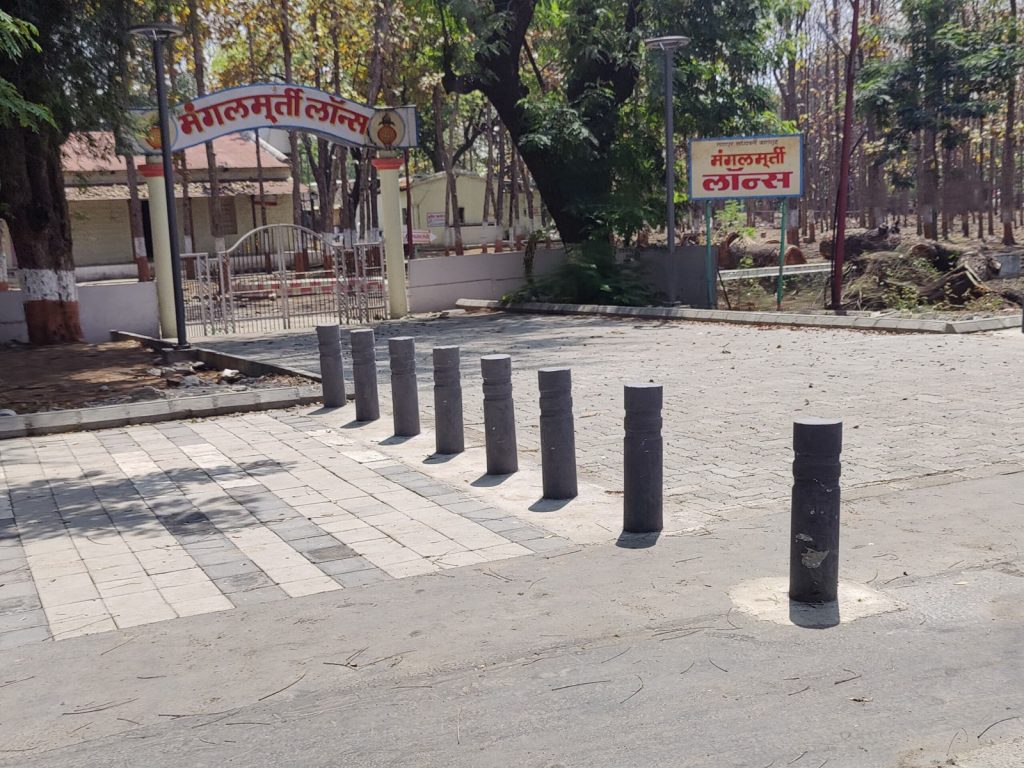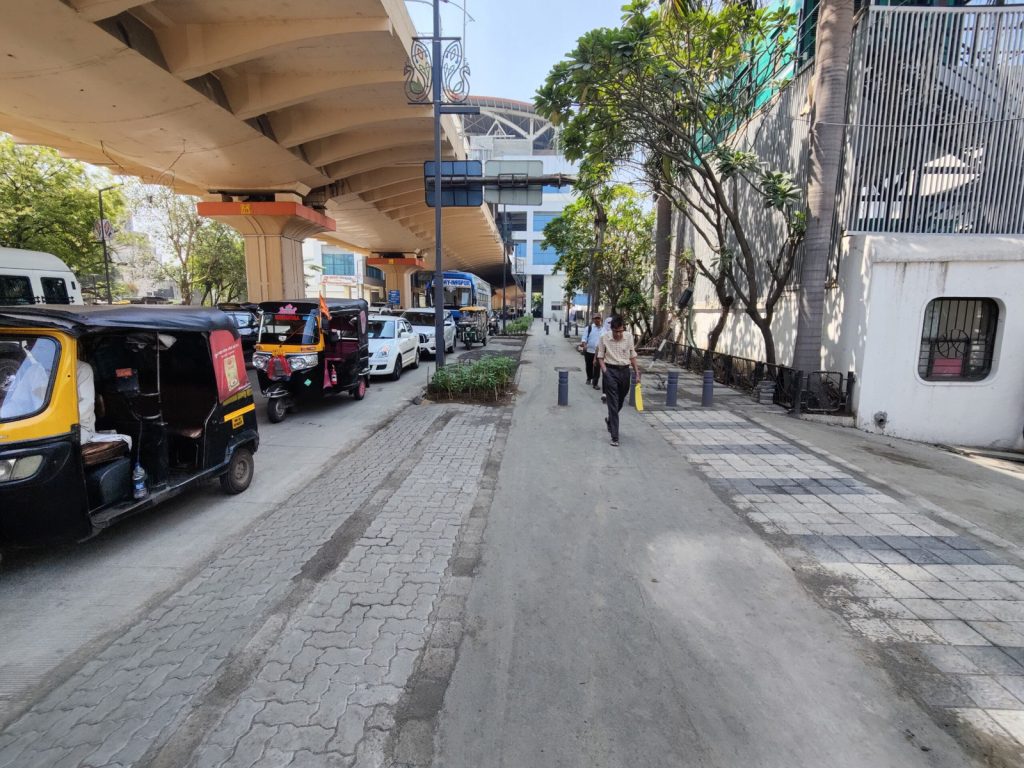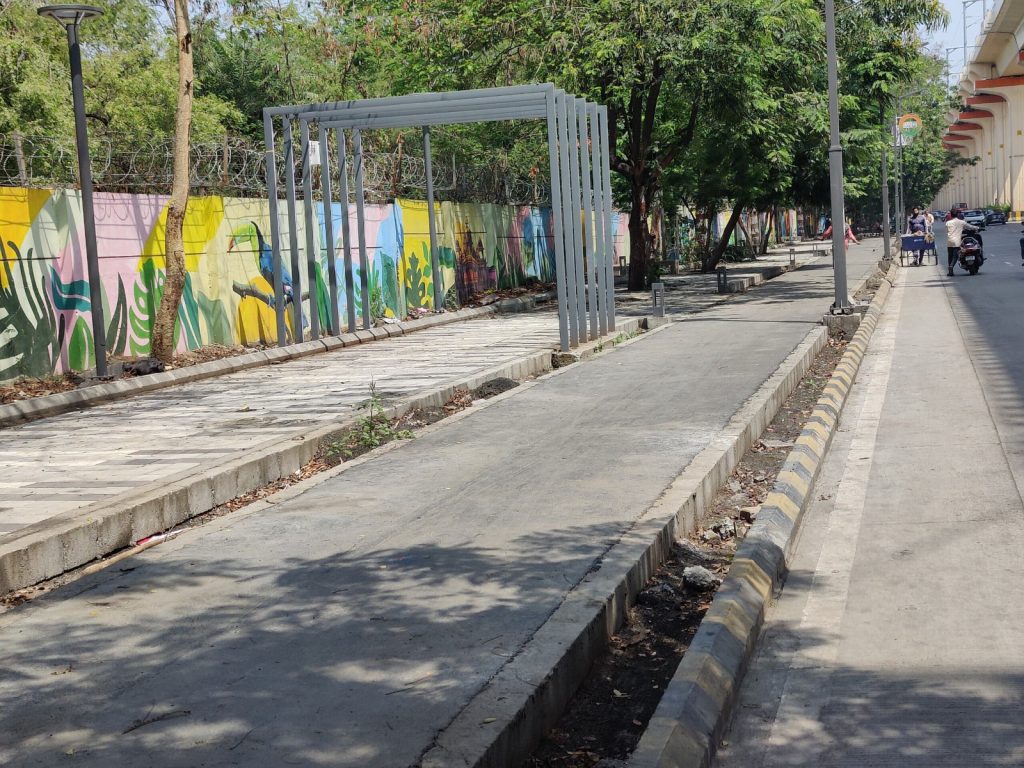The Nagpur Municipal Corporation (NMC), in partnership with ITDP India, released the Nagpur Urban Streets Assessment Report on July 07, 2025. The report is a comprehensive study evaluating the condition and usability of the city’s walking and cycling infrastructure. The report is structured in two parts, with part one focusing on ‘impact assessment’ of already redesigned streets and part two focusing on ‘situational analysis’ of current situation of the streets. It also offers strategic recommendations for a more inclusive and accessible urban environment.

The report assessed seven key stretches of street in Nagpur city- Wardha Road A (Ajni Square to Rahate Colony), Wardha Road B, Orange City Street, and Amravati Road, which were recently redesigned, and three others- Central Bazaar, Shankarnagar, Ring Road, which have not been redesigned. These are spread over approximately 10km. A triangulated methodology was employed, involving design surveys, observation surveys, and perception surveys. While design and observation studies were conducted in-house for perception surveys, 330 citizens were surveyed on-ground. These were collected between March 2024-September 2024.
These findings have been summarised by assigning a score out of 30 to each of the seven streets.
The results show promising progress on streets like Wardha Road A from Ajni Square to Rahate Colony, which scored a good score of 24.7 out of 30. At the same time, lower scores on streets like Ring Road (6.5 out of 30) highlight key opportunities for city-wide improvement and investment in better street design.

“The findings of this study give us a clear roadmap for where interventions are most needed, along with recommendations at the street and city level. We aim to apply these learnings systematically to create streets that are not only functional but also safe, accessible, and inclusive for all citizens,” said Vasumna Pant, IAS, Additional Municipal Commissioner, Nagpur Municipal Corporation.
The primary objective of this detailed assessment is to measure the impact of redesigned urban streets under initiatives like the Healthy Streets Programme, Junction Improvement Programme in Nagpur. It is critical to note that the city has already begun acting on the findings of the report.
“This report is more than just numbers; it gives us a clear direction. For example, over 80% of people on Wardha Road said the street became safer and better after the redesign. That shows what’s possible when we design streets for people, not just vehicles. At ITDP India, we’re supporting Nagpur in using these findings to create safer, more accessible streets across the city,” said Pranjal Kulkarni, Programme Manager, ITDP India.
A summary of the scores:
| Rank | Street Name | Design Score (Out of 10) | Observation Score (Out of 10) | Perception Score (Out of 10) | Total (Out of 30) |
| 1 | Wardha Road A | 8 Good | 8 Good | 8.75 Good | 24.75 |
| 2 | Wardha Road B | 6.25 Unsatisfactory | 6.25 Unsatisfactory | 6.25 Unsatisfactory | 18.75 |
| 3 | Shankarnagar Road | 4.25 Unsatisfactory | 2 Poor | 8.25 Good | 14.5 |
| 4 | Amravati Road | 3 Poor | 3.75 Unsatisfactory | 5.5 Unsatisfactory | 12.25 |
| 5 | Orange City Road | 4.75 Unsatisfactory | 2.5 Poor | 5.75 Unsatisfactory | 13 |
| 6 | Central Bazaar Road | 1.75 Poor | 0.5 Poor | 4.5 Unsatisfactory | 6.75 |
| 7 | Ring Road | 1.5 Poor | 1.25 Poor | 3.75 Unsatisfactory | 6.5 |
Note: Wardha road (Ajni Sq. to Rahate Colony Sq.) has performed well on all aspects.
The assessment reinforces NMC’s commitment to making streets safer for all, particularly vulnerable users like children, the elderly, and persons with disabilities. With a strong emphasis on non-motorised transport (NMT), this study aims to support evidence-based planning by highlighting both strengths and gaps in the current street infrastructure.

Key Findings from surveys
1. Best-rated street among four redesigned streets – Wardha Road (Ajni Square to Rahate Colony Square):
This 1.3km stretch received the highest score across all evaluation criteria, design, observation, and perception. Over 80% of users reported improvements in walkability, cyclability, and safety. The presence of shaded, segregated non-motorised transport (NMT) zones and placemaking elements such as seating areas, and safe junctions played a critical role in the positive feedback. During observation studies, 100% of the pedestrians observed were walking on the footpath itself. The street, however, did face issues around vehicles being parked on the footpath, and lack of cycling infrastructure on some stretches.
2 Non-designed streets needing immediate improvement – Central Bazaar Road (Lokmat Square to Bajajnagar Square) and Ring Road
The findings highlight two streets with immense potential for improvement. Streets like Central Bazaar (Lokmat Square to Bajajnagar Square) and Ring Road scored lower primarily due to discontinuous footpaths, encroachments. In Central Bazaar, most pedestrians observed were walking on the carriageway, while in Ring Road, over 90% were seen walking alongside traffic. Despite the lack of cycle tracks, Ring Road saw the highest cyclist count—160 per hour—underscoring the urgent need for dedicated cycling infrastructure. It is crucial to note that the Nagpur Municipal Corporation has already begun taken corrective measures by upgrading the Central Bazaar Road, with the stretch from VNIT Gate to Kachipura Chowk currently under transformation. These changes signal a positive step toward making streets safer and more inclusive for all users.
3. Over-speeding across the city:
Speed surveys conducted using speed guns revealed peak vehicular speeds of over 60 km/h on most roads, with some stretches (Orange City Road and Amravati Road) recording up to 75 km/h for two-wheelers. These speeds exceed national and international safe street design guidelines, drastically increasing the risk of fatalities. The ideal speed limit within cities should be around 30-40 kmph. Nagpur Municipal Corporation is committed to addressing these issues at the earliest.
| # | Street Name | Peak Vehicular Speed Car | Most Recurring Speed Car | Peak Vehicular Speed 2-Wheeler | Most Recurring Speed 2-Wheeler |
| 1 | Amravati Road | 54 | 51 | 75 | 48 |
| 2 | Central Bazaar Road | 62 | 47 | 57 | 47 |
| 3 | Orange city Road | 56 | 52 | 70 | 53 |
| 4 | Shankarnagar Road | 47 | 44 | 65 | 46 |
| 5 | Ring Road | 60 | 47 | 61 | 49.5 |
| 6 | Wardha Road | 63 | 58 | 61 | 58 |
4. Junction and crossing issues:
At busy junctions, many surveyed users—especially elderly citizens and children—highlighted the need for safer crossing experiences. Out of 330 respondents, nearly half identified the fear of fast-moving vehicles as the biggest concern, followed by the lack of designated crossing points. Observations pointed to issues like inadequate signal phasing, absence of pedestrian refuges, and poor junction design. Recognising these concerns, the municipal corporation has initiated a Junction Improvement Programme, marking an important step toward creating safer, more accessible intersections for all road users.
5. Insufficient lighting
Ensuring well-lit streets emerged as a key opportunity to enhance safety and comfort for all users. Streets like Amravati Road, Ring Road, and Central Bazaar Road were noted for having insufficient lighting. NMC recognised that addressing this can significantly improve walkability and foster a greater sense of security after dark.
6. Safety for Kids:
“The assessment revealed encouraging signs on streets like Wardha Road and Shankarnagar Road, which stood out as relatively safer for children. Wardha Road offered segregated walking and cycling spaces, while Shankarnagar Road’s narrower two-lane design naturally slowed down traffic, enhancing safety. However, most other streets lacked traffic calming features and safe pedestrian crossings. With over 65% of respondents voicing safety concerns for children, the findings highlight a clear opportunity for the city to prioritise Safe School Zones and create streets that support safe, independent travel for young pedestrians.
The report recommend NMC to take up the following steps to achieve city-wide street transformation. NMC has already begun the process of implementing some of these suggestions, and is also in the process of incorporating the others :
1. Adoption of a dedicated NMT Policy: Leading cities in Maharashtra like PCMC, Pune have NMT policies, making it critical for Nagpur to create one, in line with local goals to promote walkability, cycling, and road safety. This work has already commenced at NMC.
2. Development of a City-wide NMT Network Plan: This plan can look into creating interconnected networks that are safe to walk and cycle, so end-to-end commute is possible. This plan is already under preparation by NMC.
3. Traffic Calming Policy: Every city has different streets like arterial roads/ local roads which need different approaches to reduce speed. A city-wide policy can help define road speeds on these various categories of road and also spell out the interventions needed to keep speeds under control. For example, Pune has a speed-breaker policy.
4. Creating Urban Street Design Guidelines: There are multiple agencies involved in road development in Nagpur like PwD, NMC, and Nagpur Improvement Trust. This common guideline will help create a uniform template for materials, design, and execution of projects which all agencies can abide by.
5. Implementation of Safe School Zones: The report through perception studies found that the majority of streets are perceived to be unsafe for kids. To improve safety, accessibility, and reduce traffic congestion around schools, Safe School Zone is a start.
A Vision for the Future
This assessment marks a pivotal moment in Nagpur’s journey towards becoming a people-centric, walkable city. By building on the findings and recommendations of this report, NMC is poised to scale up efforts in creating safer, healthier, and more equitable streets.
“The findings serve as a reminder that there is still work to be done. On some streets, such as the Ring Road, 100% of people were forced to walk on the road because the footpaths were not functioning. Even on redesigned roads, more than half of the people still felt unsafe while crossing. We are assured that Nagpur city will work towards fixing these gaps through better street design, policy reforms, better planning practices and on-ground execution,” said Siddhartha Godbole, Senior Associate, ITDP India
As we move forward, the report serves not just as a retrospective analysis but as a blueprint for progress, where streets belong to people, not just vehicles.
👉 Click here to read the latest Gujarat news on TheLiveAhmedabad.com



